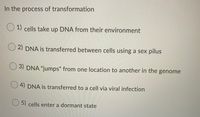
Human Anatomy & Physiology (11th Edition)
11th Edition
ISBN: 9780134580999
Author: Elaine N. Marieb, Katja N. Hoehn
Publisher: PEARSON
expand_more
expand_more
format_list_bulleted
Concept explainers
Topic Video
Question

Transcribed Image Text:### Understanding the Process of Transformation
In the biological process known as transformation, cells undergo several intricate mechanisms to alter their genetic material. Below are various methods through which DNA transformation can take place:
**1) Cells take up DNA from their environment:**
In this process, cells actively acquire external DNA from their surroundings. This extrinsic DNA is often integrated into the cell's own genome, leading to genetic variation and potentially new functionalities.
**2) DNA is transferred between cells using a sex pilus:**
This is typically referred to as bacterial conjugation. A sex pilus is a bridge-like structure that facilitates direct transfer of DNA from one cell to another, ensuring the recipient cell acquires a portion of the donor's genetic information.
**3) DNA "jumps" from one location to another in the genome:**
Here, DNA transposition occurs. Specific segments of DNA, known as transposable elements or "jumping genes," move to different locations within the genome. This can result in mutations, gene disruption, or even new gene formation.
**4) DNA is transferred to a cell via viral infection:**
This process is known as transduction. Viruses that infect bacteria, termed bacteriophages, can carry DNA from one bacterial cell to another. When the virus infects a new cell, it introduces that DNA, causing genetic changes.
**5) Cells enter a dormant state:**
In certain conditions, cells can enter a state of dormancy. During this phase, their metabolic activities are significantly reduced, and some genetic transformations may take place in preparation for future cell activity when favorable conditions return.
---
Understanding these mechanisms is crucial for advanced studies in genetics, biotechnology, and evolutionary biology as they highlight the diverse ways genetic information can be exchanged and modified across different organisms.
Expert Solution
This question has been solved!
Explore an expertly crafted, step-by-step solution for a thorough understanding of key concepts.
Step by stepSolved in 2 steps

Knowledge Booster
Learn more about
Need a deep-dive on the concept behind this application? Look no further. Learn more about this topic, biology and related others by exploring similar questions and additional content below.Similar questions
- Explain one other way beyond conjugation, transformation, and transduction to introduce new genes into cells.arrow_forwardDescribe the four phases of bacterial cell division. Where would horizontal gene transfer occur? Where would sporogenesis occur? If antibiotics generally target cells which are growing and dividing as fast as they can, when would antibiotics be most effective? If a culture had 4 cells to begin with and has a generation time of 60 minutes, how long would it take to get 1,048,576 cells?arrow_forwardExplain two ways that some viruses can cause cancer. A couple of sentences answer is fine.arrow_forward
- A bacteriophage has inserted its DNA into a bacterial host and replicated as a part of the host’s genome for several generations as the host reproduces. For this virus to assemble more infectious viral particles, what must it do? Switch to the lysogenic cycle of replication Switch to the vicious cycle of replication Purposefully mutate its own genes Switch to the lytic cycle of replicationarrow_forwardAnswer choices: 1) a cell with two complete sets of chromosomes 2) a chromosome pair, one maternal and one paternal 3) the events that occur from the time a cell forms until the time it divides 4) time of cell growth 5) cell division that maintains chromosome number 6) a reproductive mode by which offspring are produced by one parent only 7) an exact copy of a chromosomearrow_forwardThe refers to the potential that a stem cell has to give rise to many different cell types. A) Cellular Determination B) monopotency C) Cellular Differentiation D) Pleuripotency E) none of the abovearrow_forward
arrow_back_ios
arrow_forward_ios
Recommended textbooks for you
 Human Anatomy & Physiology (11th Edition)BiologyISBN:9780134580999Author:Elaine N. Marieb, Katja N. HoehnPublisher:PEARSON
Human Anatomy & Physiology (11th Edition)BiologyISBN:9780134580999Author:Elaine N. Marieb, Katja N. HoehnPublisher:PEARSON Biology 2eBiologyISBN:9781947172517Author:Matthew Douglas, Jung Choi, Mary Ann ClarkPublisher:OpenStax
Biology 2eBiologyISBN:9781947172517Author:Matthew Douglas, Jung Choi, Mary Ann ClarkPublisher:OpenStax Anatomy & PhysiologyBiologyISBN:9781259398629Author:McKinley, Michael P., O'loughlin, Valerie Dean, Bidle, Theresa StouterPublisher:Mcgraw Hill Education,
Anatomy & PhysiologyBiologyISBN:9781259398629Author:McKinley, Michael P., O'loughlin, Valerie Dean, Bidle, Theresa StouterPublisher:Mcgraw Hill Education, Molecular Biology of the Cell (Sixth Edition)BiologyISBN:9780815344322Author:Bruce Alberts, Alexander D. Johnson, Julian Lewis, David Morgan, Martin Raff, Keith Roberts, Peter WalterPublisher:W. W. Norton & Company
Molecular Biology of the Cell (Sixth Edition)BiologyISBN:9780815344322Author:Bruce Alberts, Alexander D. Johnson, Julian Lewis, David Morgan, Martin Raff, Keith Roberts, Peter WalterPublisher:W. W. Norton & Company Laboratory Manual For Human Anatomy & PhysiologyBiologyISBN:9781260159363Author:Martin, Terry R., Prentice-craver, CynthiaPublisher:McGraw-Hill Publishing Co.
Laboratory Manual For Human Anatomy & PhysiologyBiologyISBN:9781260159363Author:Martin, Terry R., Prentice-craver, CynthiaPublisher:McGraw-Hill Publishing Co. Inquiry Into Life (16th Edition)BiologyISBN:9781260231700Author:Sylvia S. Mader, Michael WindelspechtPublisher:McGraw Hill Education
Inquiry Into Life (16th Edition)BiologyISBN:9781260231700Author:Sylvia S. Mader, Michael WindelspechtPublisher:McGraw Hill Education

Human Anatomy & Physiology (11th Edition)
Biology
ISBN:9780134580999
Author:Elaine N. Marieb, Katja N. Hoehn
Publisher:PEARSON

Biology 2e
Biology
ISBN:9781947172517
Author:Matthew Douglas, Jung Choi, Mary Ann Clark
Publisher:OpenStax

Anatomy & Physiology
Biology
ISBN:9781259398629
Author:McKinley, Michael P., O'loughlin, Valerie Dean, Bidle, Theresa Stouter
Publisher:Mcgraw Hill Education,

Molecular Biology of the Cell (Sixth Edition)
Biology
ISBN:9780815344322
Author:Bruce Alberts, Alexander D. Johnson, Julian Lewis, David Morgan, Martin Raff, Keith Roberts, Peter Walter
Publisher:W. W. Norton & Company

Laboratory Manual For Human Anatomy & Physiology
Biology
ISBN:9781260159363
Author:Martin, Terry R., Prentice-craver, Cynthia
Publisher:McGraw-Hill Publishing Co.

Inquiry Into Life (16th Edition)
Biology
ISBN:9781260231700
Author:Sylvia S. Mader, Michael Windelspecht
Publisher:McGraw Hill Education